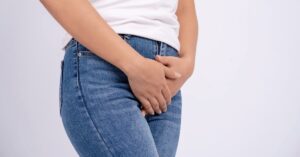
Polycystic Ovary Syndrome (PCOS): Diagnosis, Research & Management
Polycystic Ovary Syndrome (PCOS) is a common endocrine disorder that affects individuals with ovaries, often during their reproductive years. Characterized
Gynaecology > Heavy Periods

Find Out More


Heavy periods, medically known as menorrhagia, can significantly impact a woman’s quality of life.
If you are experiencing unusually heavy menstrual bleeding, our clinic is here to help you understand and manage this common issue. We are committed to providing the highest standards of service and are fully dedicated to assisting you.

Heavy periods involve the loss of an excessive amount of blood during a menstrual period. Normal blood loss typically ranges from 30 to 60mls or 2 to 4 tablespoons.
If you are unsure whether your bleeding is abnormal, key indicators of a heavy period also include needing to use both towels and tampons simultaneously, changing pads every two hours or less, passing large blood clots, waking at night to change your pad, or experiencing leakage onto clothes or bedsheets.
Menorrhagia can also result from anticoagulants and certain chemotherapy drugs. Additionally, having an intrauterine contraceptive device (IUD) fitted can sometimes cause heavy bleeding, particularly in the first 3 to 6 cycles post-insertion.
Bleeding after childbirth is known as lochia, and is completely normal. It consists of blood, mucus, and uterine tissue shed from the lining of the uterus as it returns to its non-pregnant size. It lasts for approximately 2 – 6 weeks and is the body’s process of clearing the womb lining after pregnancy.
Diagnosis for heavy bleeding may require a pelvic exam, blood test, or ultrasound. Depending on your diagnosis, treatment could involve hormone-based medication, hormonal implants or injections, NSAIDs (anti-inflammatory medication), or surgery.


Several conditions can lead to heavy periods, including polycystic ovary syndrome (PCOS), pelvic inflammatory disease (PID), fibroids, endometriosis, adenomyosis, cervical or endometrial polyps (non-cancerous growths), underactive thyroid, clotting disorders, or cancer.
Each of these conditions can affect the menstrual cycle, causing excessive bleeding and discomfort. Seeking medical advice is crucial for proper diagnosis and management of heavy periods, as treatment options vary depending on the underlying cause.
Accurate diagnosis of menorrhagia is crucial for effective treatment. During your visit to our clinic, our experienced healthcare providers will:
Use our online booking engine or book your test by giving us a call.
On the online booking engine select the “appointment type” you need.
You will be seen by one of our friendly doctors or trained clinicians.

Be prepared to discuss your menstrual history in detail, including the frequency, duration, and heaviness of your periods. Note any changes you have noticed recently. Take note of any other symptoms related to your menstrual cycle or in general health that might be relevant, such as pain, fatigue, or changes in mood. Make a list of all medications, vitamins, and supplements you currently take, and write down any questions or concerns you have about your menstrual health.

Your healthcare provider will likely perform a pelvic exam to check for any abnormalities in the uterus or ovaries. Depending on your symptoms and medical history, they may order tests such as blood tests (to check for anaemia or thyroid problems), ultrasound (to visualise the uterus and ovaries), or a biopsy (to examine uterine tissue).

Based on the examination and test results, your healthcare provider will explain the likely cause of your heavy periods. This could range from hormonal imbalances to structural issues like fibroids or polyps. You will receive recommendations for treatment, which may include medications, procedures, or, in some cases, surgery. If further monitoring or treatment is needed, your provider will outline the next steps and schedule any necessary follow-up appointments.
Incorporated
in 1998
Experienced doctors & a professional team
Registration
not needed
Up-to-date with the latest treatments & testing
Strictly
confidential
Experienced doctors & a professional team
Affordable private
health care
Transparent fee structure with no hidden charges
We work with experienced consultants & healthcare professionals who have received positive feedback from our patients, and with whom we have established long-term relationships.
Latest Episode
Tune in to our podcast to explore the world of healthcare and learn from distinguished special guests. We cover everything from preventative measures to cutting-edge treatments so that you can stay informed and up-to-date on health-related things.

Polycystic Ovary Syndrome (PCOS) is a common endocrine disorder that affects individuals with ovaries, often during their reproductive years. Characterized

Menopause is a natural biological process that marks the end of a woman’s reproductive years, typically occurring between ages 45

There has been an increased push of vaginal cleansing and douching products and practices. Vaginal discharge is a normal and
Subscribe for latest updates & news


From same-day private GP and blood test appointments to visa medicals, a sexual and reproductive health clinic, and preventative health screenings, we are here to help.
Contact Us
Accepted Insurance Companies






Please note that Walk-in Clinic is a private medical centre & not an NHS service. Harley Walk-in Clinic Ltd company registration no. 07472804